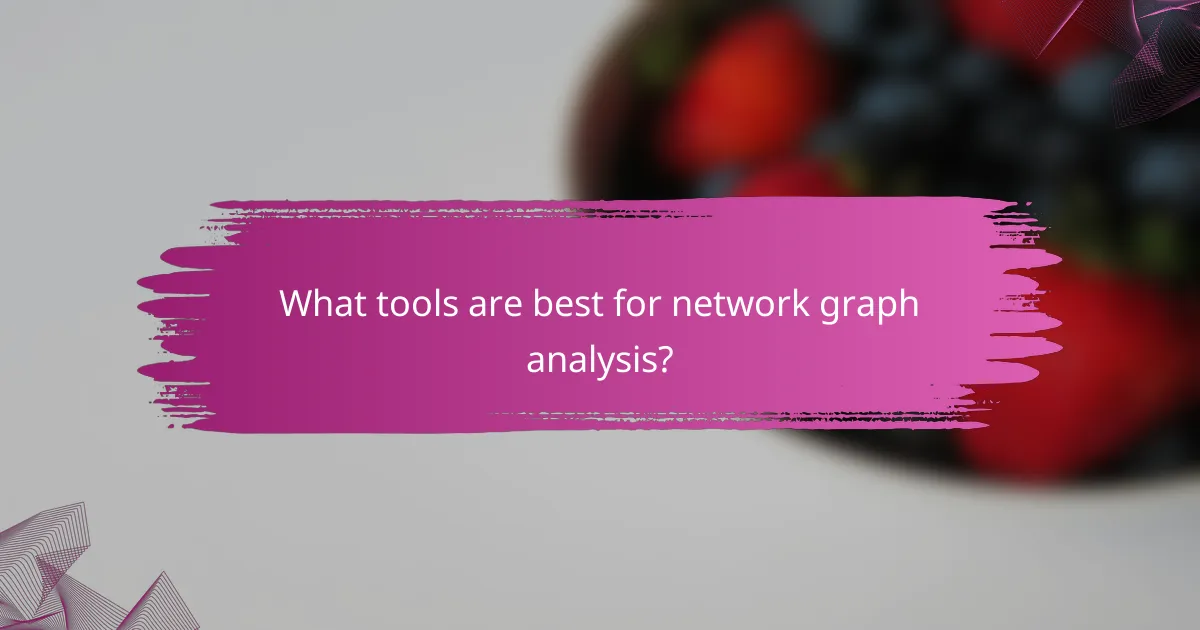Network graphs serve as powerful tools for visualizing relationships and interactions within various entities, such as customers, products, and suppliers. By mapping these connections, businesses can gain insights into patterns and optimize their processes, leading to improved decision-making and efficiency. Effective analysis relies on specialized tools that facilitate relationship mapping and data interaction, ultimately enhancing connectivity in e-commerce.

How can network graphs improve e-commerce connectivity?
Network graphs enhance e-commerce connectivity by visualizing relationships and interactions among various entities, such as customers, products, and suppliers. This visualization aids in identifying patterns and optimizing processes, ultimately leading to better decision-making and increased efficiency.
Enhanced customer insights
Network graphs provide a clear view of customer interactions, revealing preferences and behaviors. By analyzing these connections, e-commerce businesses can segment their audience more effectively and tailor their offerings to meet specific needs.
For instance, mapping customer relationships can highlight which products are frequently purchased together, allowing for targeted promotions and personalized marketing efforts. This leads to improved customer satisfaction and loyalty.
Optimized supply chain management
Utilizing network graphs in supply chain management helps visualize the flow of goods and information between suppliers, manufacturers, and retailers. This clarity enables businesses to identify bottlenecks and inefficiencies in their supply chain.
By analyzing these connections, companies can make informed decisions about inventory levels and supplier relationships, ultimately reducing costs and improving delivery times. For example, a company might discover that consolidating shipments from certain suppliers can lead to significant savings.
Improved marketing strategies
Network graphs facilitate the analysis of marketing channels and their effectiveness in reaching target audiences. By mapping out the interactions between different marketing efforts, businesses can pinpoint which strategies yield the best results.
For example, a business may find that social media campaigns generate more engagement when linked to email marketing efforts. This insight allows for the optimization of marketing budgets and resource allocation, maximizing return on investment.
Streamlined product recommendations
Network graphs can enhance product recommendation systems by analyzing customer purchase patterns and preferences. By visualizing these relationships, e-commerce platforms can suggest products that are more likely to resonate with individual customers.
For instance, if a customer frequently buys outdoor gear, the system can recommend related items such as hiking boots or camping equipment. This targeted approach not only increases sales but also improves the overall shopping experience for customers.

What tools are best for network graph analysis?
Effective network graph analysis relies on specialized tools that facilitate relationship mapping, connectivity analysis, and data interaction. The best tools combine robust data handling capabilities with intuitive visualization features.
Neo4j for graph databases
Neo4j is a leading graph database that excels in managing complex relationships between data points. It uses a property graph model, allowing users to store data as nodes, relationships, and properties, which makes querying relationships straightforward.
When using Neo4j, consider its Cypher query language, which is designed for graph traversal. This enables users to perform efficient queries on large datasets, making it suitable for applications like social network analysis or fraud detection.
Gephi for visualization
Gephi is an open-source tool specifically designed for visualizing and exploring large network graphs. It provides a user-friendly interface that allows users to manipulate graph layouts and apply various algorithms for better insights.
With Gephi, you can import data from various sources and apply filters to focus on specific relationships. It’s particularly useful for academic research or presentations where visual clarity is essential.
Tableau for data interaction
Tableau is a powerful data visualization tool that supports interactive analysis of network graphs. It allows users to connect to various data sources and create dynamic dashboards that can highlight relationships and trends in real time.
When using Tableau for network analysis, take advantage of its drag-and-drop interface to create visualizations that can be easily shared with stakeholders. This tool is ideal for business environments where data-driven decisions are crucial.

How to implement network graphs in e-commerce?
Implementing network graphs in e-commerce involves mapping relationships between products, customers, and transactions to enhance connectivity analysis and data interaction. This approach helps businesses understand customer behavior, optimize inventory, and improve marketing strategies.
Data collection and integration
Effective data collection is crucial for building accurate network graphs. Gather data from various sources such as customer transactions, product catalogs, and user interactions on your e-commerce platform. Integrate this data into a unified system to ensure consistency and reliability.
Consider using APIs to pull data from different platforms, such as payment gateways or CRM systems. This integration allows for a more comprehensive view of relationships and interactions, which is essential for meaningful analysis.
Graph modeling techniques
Graph modeling techniques help visualize and analyze the relationships within your e-commerce data. Common methods include node-link diagrams, where nodes represent entities like products or customers, and edges represent their connections. Choose a modeling technique that best fits your data and analytical goals.
For instance, using community detection algorithms can reveal clusters of related products or customer segments. This insight can guide targeted marketing efforts and inventory management decisions.
Real-time data updates
Real-time data updates are vital for maintaining the accuracy of your network graphs. Implement systems that allow for continuous data streaming from your e-commerce platform to ensure that your graphs reflect the most current relationships and interactions.
Consider using technologies like WebSocket or server-sent events to push updates instantly. This capability enables you to respond quickly to changes in customer behavior or inventory levels, enhancing your decision-making process.

What are the key attributes of effective network graphs?
Effective network graphs are characterized by clear node relationships, meaningful edge weights, and appropriate data density. These attributes help in visualizing and analyzing complex relationships and interactions within the data.
Node relationships
Node relationships define how individual entities connect within a network graph. Each node represents an entity, and the connections between them illustrate their relationships, such as collaboration, communication, or influence. Understanding these relationships is crucial for identifying key players and analyzing the overall structure of the network.
To effectively map node relationships, consider using different colors or shapes to represent various types of entities. For example, in a social network, users could be represented as circles, while organizations might be depicted as squares. This differentiation aids in quickly grasping the network’s dynamics.
Edge weights
Edge weights quantify the strength or significance of the connections between nodes. They can represent various metrics, such as frequency of interaction, volume of transactions, or level of influence. Assigning appropriate weights helps prioritize relationships and highlights the most critical connections within the network.
When analyzing edge weights, consider using a scale to categorize connections. For instance, you might classify interactions as strong, moderate, or weak based on their frequency. This categorization allows for a clearer understanding of which relationships warrant further investigation or action.
Data density
Data density refers to the amount of information represented in a network graph relative to its size. A well-balanced data density ensures that the graph is neither too cluttered nor too sparse, allowing for effective analysis and interpretation. High data density can obscure important relationships, while low density may fail to convey the network’s complexity.
To achieve optimal data density, aim for a balance where key relationships are visible without overwhelming the viewer. Use techniques such as filtering or clustering to manage complexity while retaining essential information. Regularly review and adjust the graph as new data becomes available to maintain clarity and relevance.

How do network graphs enhance data interaction?
Network graphs enhance data interaction by visually representing complex relationships and connections within datasets. This visualization allows users to easily identify patterns, trends, and insights that might be obscured in traditional data formats.
Facilitated data exploration
Network graphs enable users to explore data interactively, allowing for a more intuitive understanding of relationships. Users can zoom in on specific areas, filter connections, and manipulate the graph to focus on relevant data points. This exploration can reveal hidden connections that may not be immediately apparent in tabular data.
For instance, in a social network analysis, users can quickly identify influential nodes or clusters of activity by interacting with the graph. This hands-on approach fosters deeper insights and encourages users to ask new questions about the data.
Visual representation of relationships
The visual nature of network graphs makes it easier to comprehend complex relationships between entities. Each node represents an entity, while the edges illustrate the connections, allowing for quick identification of strong or weak ties. This clarity is particularly beneficial in fields like biology, sociology, and computer science.
For example, a network graph of a transportation system can help visualize routes and connections between different locations, making it easier to optimize travel paths. The immediate visual feedback aids in understanding how changes in one part of the network can affect the whole system.
Dynamic querying capabilities
Dynamic querying in network graphs allows users to filter and manipulate data in real time, enhancing the analysis process. Users can apply various criteria to highlight specific relationships or nodes, making it easier to focus on particular aspects of the data. This interactivity can significantly speed up the decision-making process.
For example, in a customer relationship management system, users can filter the graph to show only high-value customers or recent interactions, enabling targeted marketing strategies. This capability ensures that users can adapt their analysis based on evolving needs and insights.
